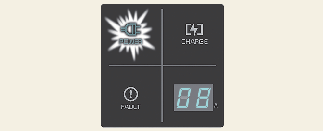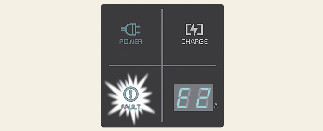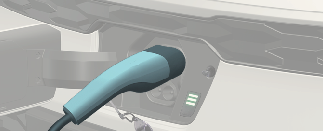Portable charge*

-
Code and Plug (Code set)
-
Control Box
-
Charging Cable and Charging Connector
The portable charge can be used when an AC Charge or DC Charge is not available by using household electricity.
* Depending on your region, this cable may not be provided in your vehicle.
Setting the charge level of the portable charger

-
A: Plug
-
B: Electric Outlet
-
Check the electric outlet's rated current before connecting the plug to the outlet.
-
Connect the plug to a household electric outlet.
-
Check the display window on the control box.
-
Press the button (1) on the back of the control box for 2 to 8 seconds to adjust the charge level. (Refer to the charging cable type and example for setting the charge level.)

-
The charge level on the display window of the control box changes every time you press the button (1).
-
When setting the charge level is complete, start charging according to the portable charge procedure.
* Example for setting the ICCB charge level
* The example is only for reference and may vary according to the surrounding environment.
|
Outlet current |
ICCB charge level |
Control box display window |
|---|---|---|
|
14–16 A |
12 A |
 |
|
12–13 A |
10 A |
|
|
10–11 A |
8 A |
|
|
8–9 A |
6 A |

Please make sure that the charge level selection matches the capacity of your circuit breaker to avoid a blown fuse.
How to connect the portable charger (ICCB: In-Cable Control Box)
-
Connect the plug to a household electric outlet.

-
A: Plug
-
B: Electric Outlet
-
-
Check if the power lamp (green) appears on the control box.

-
Depress the brake pedal and apply the parking brake.
-
Turn OFF all switches, shift to P (Park), and turn OFF the vehicle. If charging is initiated with the gear not in P (Park), the vehicle will automatically shift the gear to P (Park) to start charging.
-
Open the charging door.
For more details, refer to More Details.
-
Open the protection caps of the charging connector and the charging plug. Check if there are any foreign substances or dust.
-
Hold the charging connector handle and connect it to the vehicle charging inlet. Push the connector all the way in. If the charging connector and charging terminal are not connected properly, this may cause a fire.
-
Charging starts automatically (charging lamp appears).

-
Check if the charging indicator light (
 ) of the high voltage battery in the instrument cluster is turned ON. Charging is not active when the charging indicator light
(
) of the high voltage battery in the instrument cluster is turned ON. Charging is not active when the charging indicator light
( ) is OFF. When the charging connector is not connected properly, reconnect the charging cable to charge it again.
) is OFF. When the charging connector is not connected properly, reconnect the charging cable to charge it again.

-
After charging has started, the estimated charging time is displayed on the instrument cluster for about 1 minute.

A: Remaining Time
If you open the driver seat door whilst charging, the estimated charging time is also displayed on the instrument cluster for about 1 minute. When scheduled charging or scheduled air conditioner/heater is set, the estimated charging time is displayed as "--".
Checking charging status
When charging the high voltage battery, the charge level can be checked from outside the vehicle.
For more details, refer to More Details.

-
If you cannot open the charging door due to freezing weather, tap lightly or remove any ice near the charging door. Do not try to forcibly open the charging door.
-
Select EV → setting icon on the screen → Charging connector locking mode in the infotainment system. The charging connector is locked in the inlet at a different period according to which mode is selected.
-
Always lock mode: The connector locks when the charging connector is plugged into the charging inlet.
-
Lock whilst charging mode: The connector locks when charging starts.
For more details, refer to More Details.
The infotainment system may change after software updates. For more information, refer to the manual provided in the infotainment system and the quick reference guide.
-
-
Even though charging is possible with the EV button in the ON/START position, for your safety, start charging when the EV button is in the OFF position and the vehicle is shifted to P (Park). After charging has started, you can use electrical components such as the radio by pressing the EV button to the START or ON position.
During charging, the gear cannot be shifted from P (Park) to any other gear.
-
Depending on the condition and durability of the high voltage battery, charger specifications, and ambient temperature, the time required for charging the battery may vary.
-
If the charging connector and charging inlet are not connected properly, the connector may droop or vibrate. In this case, hold the charging connector handle and push it all the way in.
Charging status indicator lamp for a portable charger

|
Indicator |
Details |
|
|---|---|---|
|
POWER |
On: Power on |
|
|
CHARGE |
On: Charge Blink: Current limit due to high plug temperature or high internal temperature |
|
|
FAULT |
Blink: Charging interrupted |
|
|
CHARGE LEVEL |
12 |
12 A |
|
10 |
10 A |
|
|
08 |
8 A |
|
|
06 |
6 A |
|
|
The charging current changes when the charger is plugged into an electrical outlet, not the vehicle, and the button (1) is pressed for less than 1 sec. Control box
 |
||
Status/Diagnosis/Countermeasure

-
Charging connector plugged into the vehicle (POWER Green ON)
-
Plug connected to an electric outlet (POWER Green ON)
Whilst charging

-
Charge indicator (POWER Green ON/CHARGE Blue ON)
-
Charging current
Before plugging the charging connector into the vehicle (POWER Green ON, FAULT Red blink)

-
Abnormal temperature
-
ICCB (In-Cable Control Box) failure
Plugged into the vehicle (POWER Green ON, FAULT Red Blink)

-
Diagnostic device failure
-
Current leakage
-
Abnormal temperature
Leakage current failure (POWER Green ON, FAULT Red Blink)

-
After disconnecting and reconnecting the power plug, press and release the button for 2 seconds or longer to clear the error.
Power saving mode

-
The charge level indicator is turned off if there is no status change for more than 1 minute.
How to disconnect portable charger (ICCB: In-Cable Control Box)
-
Hold the charging connector handle and pull it out.

-
Make sure to completely close the charging door.
-
Disconnect the plug from the household electric outlet. Do not pull the cable when disconnecting the plug.

A: Plug
B: Electric Outlet
-
Close the protection caps of the charging connector and the charging plug to protect them from foreign substances.
-
If the personal charging connector is used, store the connector in the cable compartment.
Precautions for portable charger (ICCB: In-Cable Control Box)
-
Use the portable charger that is certified by an authorised Kia dealer/service partner.
-
Do not try to repair, disassemble, or adjust the portable charger.
-
Do not use an extension cord or adapter.
-
If a failure occurs, immediately stop using the portable charger.
-
Do not touch the plug and charging connector with wet hands.
-
Do not touch the terminal part of the AC charging connector and the AC charging inlet of the vehicle.
-
Do not connect the charging connector to the voltage that does not comply with regulations.
-
Do not use the portable charger if it is worn out or exposed or if any damage exists on the portable charger.
-
If the ICCB case and AC charging connector are damaged or cracked, or the wires are exposed in any way, do not use the portable charger.
-
Do not let children operate or touch the portable charger.
-
Keep the control box free of water.
-
Keep the normal charging connector or plug terminal free of foreign substances.
-
Do not step on the cable or cord. Do not pull the cable or cord and do not twist or bend it.
-
Do not charge when there is lightning.
-
Do not drop the control box or place a heavy object on the control box.
-
Do not place an object that can generate high temperatures near the charger when charging.
-
Charging with a worn-out or damaged household electric outlet can result in a risk of electric shock. If you are in doubt to the household electric outlet condition, have it checked by a licensed electrician.
-
Stop using the portable charger immediately if the household electric outlet or any components is overheated or you notice burnt odours.

To prevent charging cable theft, the charging connector cannot be disconnected from the inlet when the doors are locked or the charging connector is in the Always lock mode. Unlock all doors to disconnect the charging connector from the inlet.
However, if the vehicle is in the charging connector Lock whilst charging mode, the charging connector automatically unlocks from the inlet when charging is complete.
Pressing the release button on the charging connector may result in interrupted charging and connector separation even when it is locked.
If the charging connector is disconnected whilst the release button is not pressed, the connector and the inlet may be damaged.
For more details, refer to More Details.
If the release button does not work even after all the doors are unlocked, pull the emergency lift cable in the motor room and press the release button in the connector to disconnect it from the vehicle. If the release button still does not work, we recommend that you visit an authorised Kia dealer/service partner.